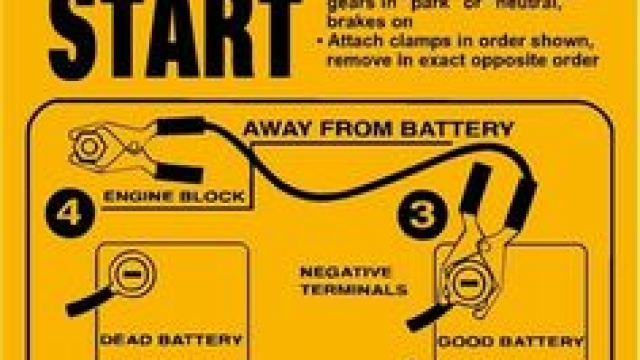Roadside Rescues: Mastering the Art of Flat Tire Change and Towing
Welcome to the world of roadside rescues! Dealing with unexpected car troubles can be a stressful experience, but fear not, as we are here to guide you through the art of flat tire change and towing. Whether you find yourself with a flat tire in the middle of a busy highway or needing a reliable towing service, we have got you covered. In this article, we will explore the ins and outs of car jump starts, car lockouts, flat tire changes, and towing, providing you with the knowledge and tips to handle these situations with confidence. So buckle up and get ready to become a master of roadside rescues! And remember, when it comes to 24/7 towing and roadside services in Chicago, "Rick’s Emergency Roadside Assistance" is your trusted partner.
1. Car Jump Starts
When it comes to unexpected car troubles, a dead battery is never a pleasant surprise. Whether you left your lights on overnight or simply encountered a faulty charging system, finding yourself stranded with a car that won’t start is undoubtedly frustrating. However, with the right knowledge and tools, performing a car jump start can be a quick and effective solution.
To begin, you’ll need a set of jumper cables and a vehicle with a working battery to serve as your power source. Ensure both cars are turned off before connecting the cables. Start by attaching one end of the positive cable (usually red) to the positive terminal of the dead battery. Then, connect the other end of the positive cable to the positive terminal of the working battery.
Next, attach one end of the negative cable (usually black) to the negative terminal of the working battery. It is important to note that the other end of the negative cable should not be connected to the dead battery’s negative terminal. Instead, find an unpainted metal surface, such as a bolt or bracket, in the engine compartment of the disabled vehicle, and securely attach the negative cable to it.
Once all connections are secure, start the vehicle with the working battery and let it run for a few minutes. This will allow the dead battery to recharge to a sufficient level. Afterward, attempt to start the disabled vehicle. If successful, carefully disconnect the cables in the reverse order in which they were connected, being mindful to avoid contact between the cable clamps.
Remember, a car jump start can provide a temporary solution to a dead battery, but it is essential to have your vehicle’s electrical system properly inspected to prevent future issues. If you find yourself in need of assistance or unable to safely perform a jump start, professional roadside services such as "Rick’s Emergency Roadside Assistance" are available 24/7 in Chicago to help get you back on the road swiftly and securely.
2. Car Lockouts
Car lockouts can be incredibly frustrating and inconvenient, but they are a common occurrence that many drivers have experienced at least once. Whether you accidentally locked your keys inside the car or misplaced them, finding yourself locked out of your vehicle can bring your day to a sudden halt. Fortunately, there are steps you can take to resolve the situation efficiently.
Firstly, it’s important to remain calm and assess your options. If you have a spare key, try to locate it nearby or contact someone who can bring it to you. In some cases, the car may have a keyless entry system that allows you to unlock the doors remotely using a smartphone app or a key fob. Checking for these alternatives can save you time and stress.
If none of these options are available, it may be necessary to seek professional assistance. Calling a reputable roadside assistance service like "Rick’s Emergency Roadside Assistance" can provide you with the help you need. They have the expertise and tools to unlock your car safely and efficiently, minimizing any potential damage to your vehicle.
Remember, attempting to unlock the car yourself using unconventional methods can be risky and may cause damage. It’s best to leave it to the professionals who have the necessary training and experience to handle car lockouts effectively. By relying on experts, you can ensure a smooth and hassle-free resolution to your car lockout situation.
Mastering the art of handling car lockouts requires preparation and knowing what steps to take. By remaining calm, exploring alternative options, and seeking professional assistance when needed, you can quickly overcome the frustration of being locked out of your car and get back on the road faster.
3. Flat Tire Change
Changing a flat tire can be a frustrating experience, but with the right knowledge and tools, you can master this essential skill. Whether you’re on the side of a busy highway or a remote country road, here are some steps to help you change a flat tire quickly and safely.
First, ensure that you are in a safe location away from traffic before attempting to change your tire. Turn on your hazard lights and use reflective triangles or flares to alert other drivers. Once you’ve established a safe zone, locate your spare tire, jack, and lug wrench. These tools are typically found in the trunk of your car, underneath the floor mat, or secured to the back of your vehicle.
Next, use the lug wrench to slightly loosen the lug nuts on the flat tire. Do not remove them completely just yet. This will make it easier to loosen them once the car is lifted off the ground. Position the jack under the designated area of your vehicle’s frame, as indicated in the owner’s manual. Pump the jack handle until the flat tire is slightly off the ground, taking care not to overextend the jack’s maximum height.
Once the car is raised, you can now fully remove the lug nuts and take off the flat tire. Carefully place the spare tire onto the wheel bolts, ensuring that the holes align with the bolts. Finger-tighten the lug nuts as much as possible to secure the spare tire in place. Lower the car back to the ground using the jack and remove it from under the vehicle. Finally, use the lug wrench to fully tighten the lug nuts in a crisscross pattern, ensuring they are secure.
Remember, changing a flat tire takes practice, so it’s beneficial to familiarize yourself with the process before an emergency occurs. By following these steps and staying calm, you’ll be able to handle a flat tire situation with confidence and get back on the road safely.



